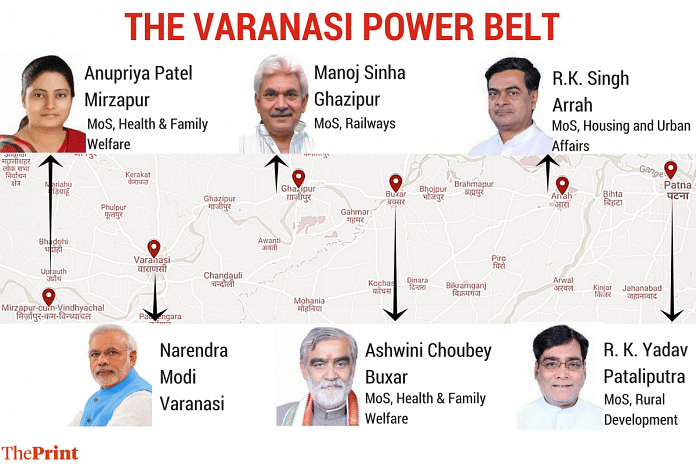Each of the five MPs along the 300-km highway corridor on either side of Varanasi is now a Union minister.
Prime Minister Narendra Modi’s constituency catchment in the Union Cabinet is the biggest stand out after Sunday’s reshuffle. Each of the five MPs along the 300-km highway corridor on either side of Varanasi is now a Union minister.
The Varanasi-Patna Gangetic power beltway starts with Mirzapur, whose MP Anupriya Patel is minister of state for health, then comes PM’s own constituency, followed by Gazipur, which is represented by communications minister Manoj Sinha.
Neighbouring Gazipur, along the same Ganga alignment, is Buxar in Bihar. Its MP Ashwani Choubey made it to the cabinet on Sunday and so did the MP from neighbouring Arrah, R.K. Singh. And then comes Ram Kirpal Yadav’s Pataliputra constituency. He is already a junior minister in the cabinet.
A close look reveals a well-crafted strategy for 2019, which also takes into account caste equations in this politically significant area of Poorvanchal. This stretch is dominated mostly by upper caste Brahmins, Rajputs and Bhumihars, followed by OBCs Koeri, Kurmi and Yadavs at one or two places.
For the BJP, this area became a political laboratory in 2014 to test whether or not the party can successfully stitch an upper caste-OBC combine. The model was replicated in the Bihar assembly elections in 2015 but didn’t yield good results for the party. However, in UP, the party did achieve considerable success with this arithmetic.
BJP and its allies managed to win 13 out of 15 assembly seats in the UP segment of the 300 km stretch. But it fared poorly in the Bihar segment, winning just two of the 19 seats in this stretch.
Through the current reshuffle, the BJP has again underlined the political significance it attaches to this beltway. “If you talk about the social structure of the specified region, it was mostly backward on development parameters and lot of migration took place in early days. In such a scenario, PM Modi’s call for development did break old caste barriers and equations. As a result, so called caste-based parties lost voters to the BJP,” says Manjeet Chaturvedi, a social scientist from Banaras Hindu University.
The BJP even aligned with some of these parties to shore up their gains. The alliance with the Apna Dal ahead of 2014 was one such instance, which is how the Patel Kurmi caste vote in the Varanasi catchment was secured and Anupriya Patel became Mirzapur MP.
Gazipur is an upper caste bastion where Bhumihars and Rajputs form the biggest chunk of electorate. It also has a good number of Kushwahas and BJP’s Manoj Sinha managed to stitch the three castes together to register victory in 2014 for the second time after 1999.
On the other side of the border, Buxar, which borders Gazipur, has been a BJP stronghold due to its majority Brahmin population. The party has won Buxar five out of six times in Lok Sabha elections since 1996. However, the worrying factor for the party came in the 2015 assembly elections, when it lost two assembly seats in Buxar, one of which went to Congress’s Munna Tiwari, an emerging Brahmin leader. The party had won these two seats in 2010.
This was a reflection of growing resentment among BJP’s traditional Brahmin vote towards the party. The induction of Ashwini Kumar Choubey is a one attempt to win back that trust ahead of 2019.
Neighbouring Arrah has a different dynamic. This is where the marauding Ranvir Sena has its origins. So, the Upper caste-lower caste divide is quite deep. The BJP always preferred to give this seat to its alliance partner JD(U) in the past.
In 2014, it fielded former home secretary R.K. Singh, who despite being an upper caste managed to go beyond the conventional caste equations due to his strong administrator image. But in 2015, BJP couldn’t win a single assembly seat in Arrah. Singh’s induction is being seen as an effort to boost the party’s prospects in 2019 now that the JD(U) is back as an ally.
Patliputra is a new constituency created just before 2009 Lok Sabha elections, by taking rural parts of Patna and some parts of Arrah. It has a large Yadav population and in 2014, the BJP’s challenge to Lalu Prasad came from here through Lalu’s old confidante Ram Kripal Yadav, who switched parties. He went on to defeat Lalu’s daughter Misa Bharti.



